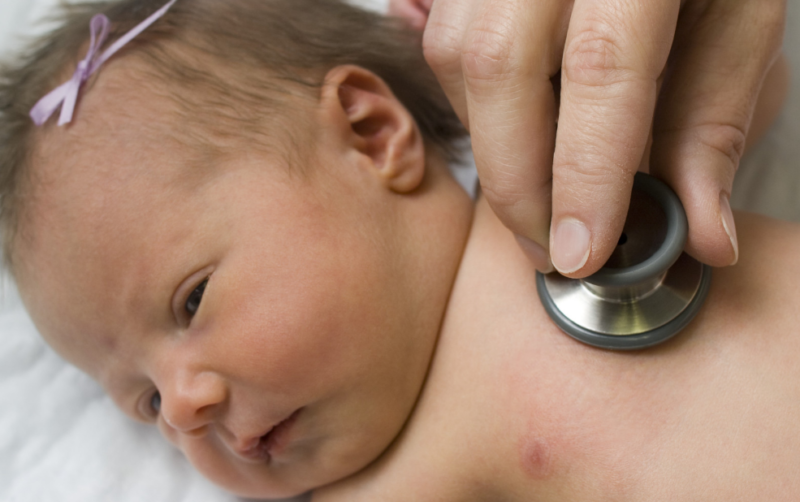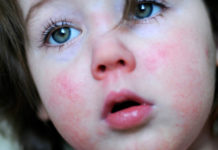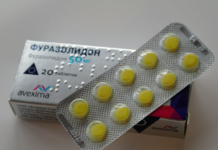Cytomegalovirus in children is an infection of a viral origin, the causative agent of which is a virus from the herpes virus group. The disease is widespread and is the most dangerous for the child's body. When ingested, the virus, multiplying inside the cells, can infect any organs and tissues.
Material Content:
What is cytomegalovirus?
CMV is the most common of all viral infections and has a high degree of transmission from person to person. The virus, with a high degree of body defenses, can be at rest and not manifest itself. But under certain circumstances or a decrease in immunity, CMV begins to actively multiply and affect the internal organs.
For the baby, the main way the virus is transmitted is through kissing. The pathogen has the ability to penetrate into all organs and tissues, but the main place of its concentration is the salivary glands.
The most dangerous virus is for newborn babies and toddlers.
Types and causes of CMV in children
In kindergarten and older children, CMV infection occurs by airborne droplets, when in a limited room the virus is transmitted from a sick person or a virus carrier to a healthy baby. A contact method of transmitting infection through toys, dishes, or other household items is not excluded.
According to the classification, CMV in children is congenital or acquired.Cytomegalovirus in pregnant women can be transmitted to an unborn baby by the placental route. In this case, infection with the virus is considered congenital, which causes serious malformations.
The earlier placental infection of the fetus takes place, the more pronounced may be the pathology of the development of the child in the future.
Also, contact with the infection can occur when the baby passes through the birth canal of an infected mother or through breast milk during feeding from the first days of his life. Any medical manipulations carried out by a child with infected tools in the hospital can also cause a virus infection. In this case, we can talk about acquired cytomegalovirus infection.
Symptoms of infection
As a rule, CMV in childhood is secretive, i.e. asymptomatic. But if the child has a weakened immune system, the clinical picture of the disease will often be similar to SARS. The manifestations of infection may be affected by concomitant pathologies of the internal organs of the child, as well as his age.
The incubation or latent period after infection lasts from 2 weeks to 2 months, after which the symptoms of cytomegalovirus infection in children will appear as follows:
- a prolonged increase in temperature to subfebrile numbers within 3-4 weeks;
- the appearance of a runny nose and mucous discharge from the nose;
- an increase in the salivary glands, accompanied by copious salivation;
- intoxication of the body in the form of weakness, increased fatigue, headache, muscle soreness;
- enlargement of the cervical lymph nodes;
- disruption of the intestines in the form of constipation or diarrhea;
- decreased appetite.
Often, in such children, the addition of bronchitis or pneumonia is observed. Since the specific symptoms of CMV are absent, the diagnosis of infection presents significant difficulties.
Features of the course in children of different age groups
Due to the unequal maturity of the immune system in children, the manifestations of CMV, depending on age, will have the following features of the course of the infectious process:
- Children under one year old. Babies infected by the mother through the placenta in late pregnancy are born with the acute stage of infection when the virus is actively propagating. At this time, the disease is clinically manifested by catarrhal phenomena, that is, cough, fever, swelling of the nasopharynx. With intrauterine infection of babies in the early stages of pregnancy, the symptoms of infection are more pronounced. Often, in such children, CNS damage, congenital hepatitis, pancreatitis, and impaired renal function are observed. With the congenital nature of CMV, only 20% of infants have clinical manifestations of the virus. Health problems can occur when a child reaches 2-3 years, when there may be a delay in mental development or a gross pathology from the internal organs.
- Children over a year old. If the infection of the child occurs after the neonatal period, when the immune system becomes more mature, the infection proceeds with the symptoms of a cold in the form of fever, cough, swollen lymph nodes, sore throat, swollen salivary glands. With preserved immune function, the body copes well with the infection. Consequences for the child are not observed.
- School children. If the infection occurred at 7 years of age or older, this viral infectious disease does not violate the development of the child, both in physical and mental development. At this age, the primary infection with the virus is most often asymptomatic, remaining in the child's body in an inactive form.
With a decrease in immunity in children of preschool and school age, the disease manifests itself in the form of a cold infection and is much easier to tolerate. The older the child, the easier the healing process is.
What is dangerous CMV for children
CMV is most dangerous for children whose infection has occurred by the placental route. The virus, entering the body of the unborn baby through the amniotic fluid, spreads to various organs.
A child born with CMV virus may already have pathological symptoms in the following form:
- prematurity;
- malnutrition;
- weakness or absence of a sucking and swallowing reflex;
- enlarged spleen and liver;
- cranial deformity;
- microcephaly;
- blindness.
In addition to the visible manifestations of CMV, which are determined immediately after the birth of the baby, additional symptoms may appear in the future in the form of convulsive syndrome, hearing loss, strabismus. This pathology can appear in the first months of a baby's life.
Sometimes a born healthy healthy baby, as he grows up, has a delay in physical and mental development of varying severity, myopia, and irregular tooth formation. Such weakened children are often exposed to colds with an often complicated course in the form of bronchitis or pneumonia.
Important! Any increase in temperature, the appearance of a runny nose, an intestinal upset in an infant in the first months of life requires the obligatory consultation of a pediatrician to exclude infection with cytomegalovirus.
Diagnostic measures
Diagnosis of the disease begins with a medical history, examination by a doctor and assessment of objective data.
But since CMV does not give specific symptoms in the clinic of the disease, the main type of diagnosis for detecting the virus belongs to laboratory tests, which include:
- clinical analysis of blood and urine;
- microscopic examination of saliva or urine;
- sowing virus culture.
A blood test for cytomegalovirus is carried out using serological research methods that can determine not only the stage of the infectious process, but also the activity of the virus.
These include:
- ELISA (enzyme-linked immunosorbent assay) - the detection of protective antibodies lgG and lgM, the presence of which indicates the presence of immunity to the virus. If lgM is present, then primary infection has occurred, and if lgG is present, then virus-bearing occurs. If the analysis contains cytomegalovirus lgG positive with an increase in the indicator during repeated blood tests, this indicates the activity of the process. In the absence of protective antibodies, the presence of CMV is not determined.
- PCR (polymerase chain reaction) - a study of biological environments such as blood, urine, saliva for the presence of herpes DNA type 5. This analysis allows you to determine the degree of virus reproduction in the body.
These specific reactions are the most accurate, making it possible to establish the presence of CMV even in the absence of clinical manifestations of infection, which is an important point in the diagnosis of pathology, especially of a congenital nature.
Treatment methods
Since it is impossible to treat cytomegalovirus, therapeutic measures are aimed at reducing the activity of the virus, the rehabilitation of chronic diseases of internal organs and increasing the protective forces of the child's body.
If the disease has a latent course, then treatment is not required.
In this case, the child needs the following measures to maintain immunity at a high level:
- balanced diet;
- sufficient consumption of fresh vegetables and fruits;
- tempering procedures;
- active games in the fresh air;
- full sleep.
During seasonal epidemics of colds, vaccination is recommended, as well as an additional intake of vitamin complexes.
If the course of the CMV process is acute, the treatment of cytomegalovirus is carried out with specific drugs, such as:
- antiviral agents - "Ganciclovir", "Foscarnet";
- interferons - "Viferon";
- anticytomegalovirus immunoglobulin - "Cytotect".
In addition to antiviral therapy, an addition is the following symptomatic treatment prescribed to relieve the negative manifestations of infection:
- intravenous administration of various solutions to relieve intoxication;
- broad-spectrum antibiotics when attaching a secondary infection;
- vitamin therapy;
- according to indications - corticosteroids;
- immunomodulators.
After stopping the acute process, it is possible to prescribe massage, physiotherapeutic procedures.
With intrauterine infection of the child, CMV, accompanied by severe clinical manifestations of the disease, treatment is carried out in a hospital.
Forecast and Prevention
Prevention of the infection of the child is aimed primarily at a pregnant woman.
Preventive measures:
- careful observance of personal hygiene;
- the exclusion of visits to public places of congestion of a large number of people, especially in the early stages of pregnancy;
- examination for CMV;
- in case of detection of the virus, the introduction of specific immunoglobulin.
Careful adherence to hygiene measures when caring for a child will help protect him from infection with the virus.
Teaching preschool children the rules of hygiene, good nutrition, natural herbal teas, increase the immunity of the child and, as a result, the body's resistance to viral infection.
When infection of the baby virus occurs in the placental way, the prognosis for the baby will be unsatisfactory, especially if there is a visible pathology immediately after birth.
The prognosis will be relatively positive in case of acquired infection of a baby under the age of one year, since in the future, with a decrease in immunity, a viral infection may manifest itself as a pathology of various organs.
When a child is infected with CMV at school age, the prognosis for later life and its development is positive.

















